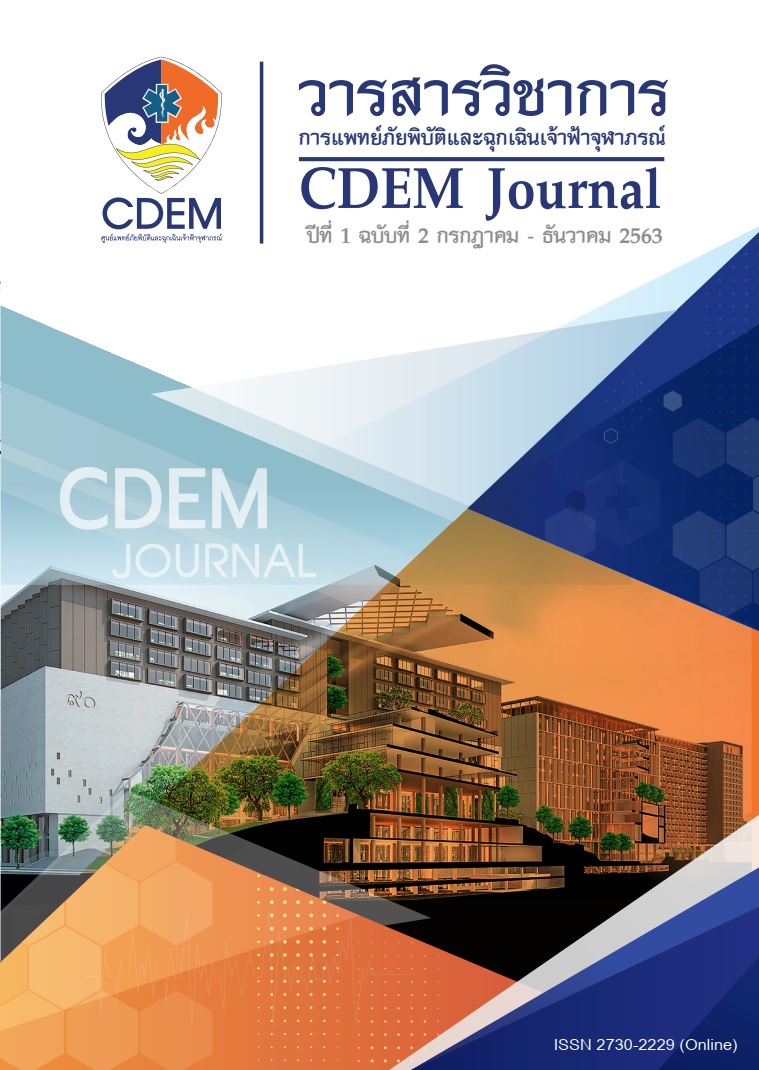How to Manage the big mass casualty in Command center from the Jungle of Western Tak
Keywords:
disaster management, mass casualty incidence, MCI, wilderness medicineAbstract
Abstract
Disaster management strongly affected mortality rate. Although all hospitals in Thailand planed for the mass casualty incidence, a few of them prepared for disaster that exceeded their surged capacity.
In 2019, Tasongyang hospital, Tak province, encountered a traffic accident with numerous severely-injured patients above their capacity. This led to the collaboration among five western Tak hospitals operated under Western Tak emergency medical service center.
The incidence was divided into 4 phases.
1.Planing: Analysis and solid planning emphasizing on resource estimation and relocation
2.Prehospital care: Establishing on scene management according to CSCATTT and resource management
3.In-hospital care: Tasongyang hospital proceeded as planned. Anyway, the bottle neck was found. First, ambulances were used both in prehospital and interfacility setting and shortly ran out. Second, the patients waiting too long for transfer still consumed the same resources with newly arrival patients. The problem was solved by relocation of resources from nearby hospitals.
4.Interfacility transfer: The process regarding to referral system was abridged. The receiving facility was well prepared.
There were total eleven patients total. Four of them were triaged red, three were yellow, while four were green. Three patients required intubation immediately. One patient need needle thoracostomy and intercostal drainage. Five of them required emergent and urgent surgical operation. Seven of them were admitted. All patients were safely discharged thereafter.
Keywords: disaster management, mass casualty incidence, MCI, wilderness medicine
References
1. Tintinalli JE, Stapczynski JS, Ma OJ, Cline DM, Meckler GD. Disaster Management. Tintinalli’s Emergency Medicine: A Comprehensive Study Guide, 8th Edition. 8th ed. McGraw-Hill Education/Medical; 2016:23-29.
2. National Association of Emergency Medical Technicians US (NAEMT). Disaster Management. PHTLS: Prehospital Trauma Life Support. 8th ed. Sudbury, MA: Jones and Bartlett; 2014:487-508.
3. Marx J, Hockberger R, Walls R. Disaster Preparedness. Rosen’s Emergency Medicine - Concepts and Clinical Practice, 2-Volume Set: Expert Consult Premium Edition - Enhanced Online Features and Print. 8th ed. London, England: W B Saunders; 2013:2457-2468.
4. Advanced Life Support Group. Major Incident Medical Management and Support: The Practical Approach at the Scene. 3rd ed. (Mackway-Jones K, ed.). Chichester, England: Wiley-Blackwell; 2011.
5. Lowes AJ, Cosgrove JF. Prehospital organization and management of a mass casualty incident. BJA Educ. 2016;16(10):323-328.
6. EAST MIDLANDS EMERGENCY MEDICINE EDUCATIONAL MEDIA. Triage Sieve. #EM3. https://em3.org.uk/foamed/18/7/2018/major-incident-management. Published July 18, 2018. Accessed September 18, 2020.
7. EAST MIDLANDS EMERGENCY MEDICINE EDUCATIONAL MEDIA. Triage Sort. #EM3. https://em3.org.uk/foamed/18/7/2018/major-incident-management. Published July 18, 2018. Accessed September 18, 2020.
8. สถาบันการแพทย์ฉุกเฉินแห่งชาติ (สพฉ.). การปฏิบัติการส่งต่อผู้ป่วยฉุกเฉินระหว่างสถานพยาบาล Interfacility Patient Transfer. กรุงเทพฯ: บริษัท อัลทิเมท พริ้นติ้ง จำกัด, 2557.
9. Google Maps. West Thai-Myanmar border. Google Maps. https://maps.google.com. Accessed August 16, 2020.
10. Ciottone GR, Biddinger PD, Darling RG, Fares S, Keim ME, Molloy MS, Suner S, editors. Ciottone's disaster medicine. Elsevier Health Sciences; 2015.
Downloads
Published
Issue
Section
License
บทความที่ได้รับการตีพิมพ์เป็นลิขสิทธิ์ของวารสารวิชาการ การแพทย์ภัยพิบัติและฉุกเฉินเจ้าฟ้าจุฬาภรณ์
ข้อความที่ปรากฏในบทความแต่ละเรื่องในวารสารวิชาการเล่มนี้เป็นความคิดเห็นส่วนตัวของผู้เขียนแต่ละท่านไม่เกี่ยวข้องกับราชวิทยาลัยจุฬาภรณ์ และคณาจารย์ท่านอื่นๆในราชวิทยาลัยฯ แต่อย่างใด ความรับผิดชอบองค์ประกอบทั้งหมดของบทความแต่ละเรื่องเป็นของผู้เขียนแต่ละท่าน หากมีความผิดพลาดใดๆ ผู้เขียนแต่ละท่านจะรับผิดชอบบทความของตนเองแต่ผู้เดียว



